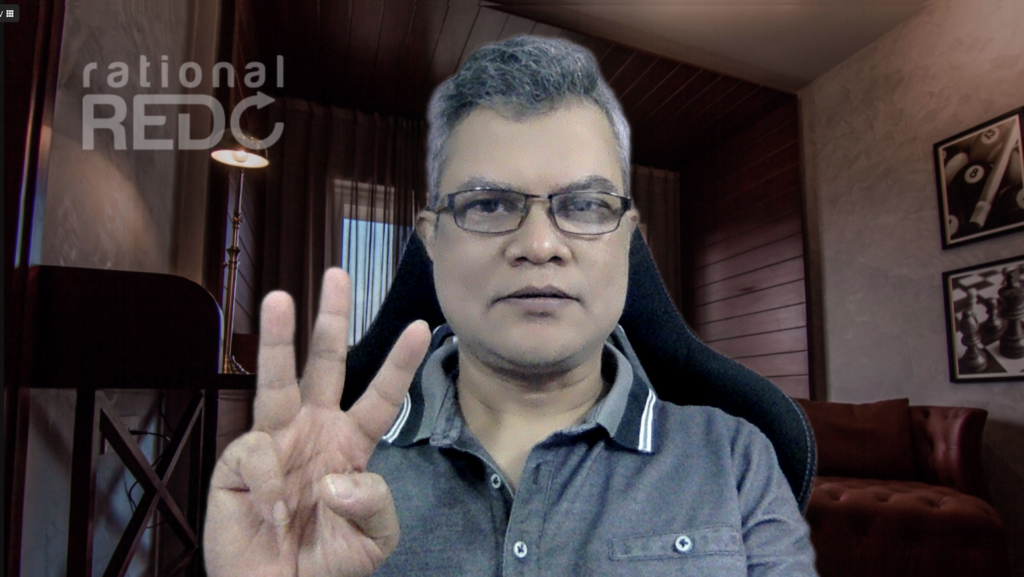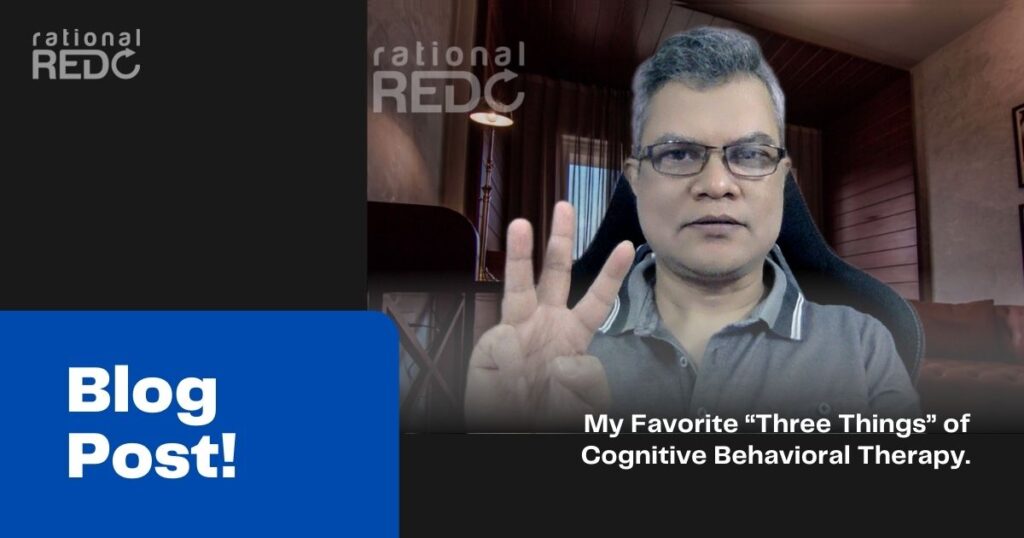A Cognitive Behavioural Therapy client recently remarked that I have “three things” for explaining so many different concepts during therapy. She even took a screenshot of me and shared it with me. Whenever she feels overwhelmed or stressed, she conjures up this mental picture and tries to recall what three things I would ask her to do, and it always helps.

It set me wondering, and I realized that CBT and REBT use several “three things” to conceptualize many complex models. Delving more into my thoughts, I came upon many areas and subjects where the rule of three is used. From computer programming to photography to writing and aviation, all these have their own rule of three or, as I call them, “three things.”
Quoting from Wikipedia about the rule of three in writing
“The rule of three is a writing principle that suggests that a trio of events or characters is more humorous, satisfying, or effective than other numbers. In addition, the audience of this form of text is more likely to remember the information conveyed because having three entities combines both brevity and rhythm with having the smallest amount of information to create a pattern.
Slogans, film titles, and various other things have been structured in threes, a tradition that grew out of oral storytelling. Examples include the Three Little Pigs, Three Billy Goats Gruff, Goldilocks and the Three Bears, and the Three Musketeers. Similarly, adjectives are often grouped in threes to emphasize an idea.”
Thus, it is a small wonder that CBT and REBT use these “three things” to help the clients and therapists understand and derive maximum benefits. The ABC model of CBT (for those not familiar with the ABC model, watch this video), which forms the very basis of CBT three things forms an integral part.
The first step in using the ABC model is identifying the “A” or the Adversity being faced. The “B” Basic attitude or belief you hold significantly influences the “C” Consequences you have. In CBT, we focus a lot on the dysfunctional emotional consequence but at the same time also lay emphasis on the behavioral aspects.
For the ABC model to be utilized appropriately, we can take the help of several “three things” or the rule of three.
There are three categories of Adversities.
- Failures, losses, or undeserved burdens
- Disapproval, disrespect, rejection, or insufficient recognition
- Discomfort or loss of pleasure
Yes, most of the adversities we face can fit into these three categories. So whenever you are disturbing yourself or experiencing an unhealthy negative emotion, try questioning yourself to see which type your disturbance fits into.
Eight unhealthy negative emotions, most have three antecedents.
The eight unhealthy emotional consequences are anxiety, anger, envy, depression, guilt, hurt, jealousy, and shame. It is beyond the scope of this blog post to examine all the eight emotions but give an example that I most often use with my clients – Anxiety. In anxiety you
- You are apprehensive of a future event
- Which will harm you or your self-esteem
- And you grossly underestimate your ability to deal with the consequences
Shoulds and musts – the primary cognitive distortion
Cognitive Distortions are erroneous thinking patterns. Dr. Albert Ellis postulated that at the core of our emotional disturbance are rigid demands or musts, termed primary distortion. Dr. Ellis referred to the indulgence of these rigid musts as “musterbating.”
There are three rigid musts.
- I must do well and win the approval of others, or else I am no good
- Other people must do “the right thing,” or they are no good and deserve to be punished.
- Life must be easy, without discomfort or inconvenience.
Thus we can have rigid demands about our performance, how others treat us, and the life quality or conditions.
Three secondary cognitive distortions
Often the “musts” create secondary cognitive distortions that contribute to your being upset.
- Awfulising: It is awful, terrible, nothing could be worse, the sky is falling
- Discomfort intolerance: It is unbearable, too difficult, too discomforting
- Deprecation: Of self, other, or life (I am not good enough, you are not good enough, life is not good enough)
Three categories of Socratic (Disputing) questions
Once we have our ABCs done, we have to move on to “D” Disputing your “iB,” your irrational beliefs or your cognitive distortions, or as it is more recently called your unhelpful Basic attitudes. Disputing is a process by which we re-frame the “iB” in a more rational and helpful “rB,” r here stands for rational. A technique that is most often used for disputing is Socratic questioning. Socratic questions are a series of focused but open questions which make the clients introspect and come up with answers to their problems rather than the therapist telling them what to do. Socratic questions too fall into three categories.
- Logical: Is what I am thinking logical? Or is it an illogical conclusion based on my cognitive distortions? A “must” is an excellent example of illogical reasoning – I want it badly; thus, I absolutely must get it! (Why? Is that a rule?)
- Empirical: What is the evidence that your reasoning is correct?
- Pragmatic: Is it practical?, does my attitude help me cope?, If I continue with my thinking will it get better?
Three healthy alternatives to the primary musts
The ABC (and D) model is effective because it helps clients develop healthy and helpful alternatives. The three healthy alternatives to the primary musts are preferences
- I always want to do well and gain the approval of others every time, but I am human, and sometimes I will not. Sometimes things will not be in my control. If that happens, I am not any less of a person, or my worth does not decrease because of it.
- I prefer that others love me, treat me well, do the right thing, but not doing so will not make me a worthless person
- I prefer life to be comfortable, fair, fun. I know it cannot always be so. Life is not transformed into a wholly negative experience when things don’t go my way. (Just that part is negative)
Three healthy alternatives to secondary cognitive distortions
Similarly, the secondary cognitive distortions or extreme attitudes have a healthy, non-extreme, and flexible counterpart
- It is bad that I am experiencing a difficult time or failed in the task. It is not awful, terrible, or end of the world. The sky hasn’t fallen.
- The situation is uncomfortable, but I can bear it.
- The negative characteristics I possess and the things I do that are bad do not transform me into a wholly bad person, a fool, or even lesser.
Eight healthy negative emotions
Many are confused when they first hear the term “healthy negative emotions,” many are confused. I then have to explain that the opposite of unhealthy negative emotions is not healthy positive emotions. When you face Adversity, the consequence will be a negative emotion. Wanting to be positive always and in the face of all adversities is “toxic positivity” and is to be avoided. Therapy aims to convert your dysfunction to function. Thus, we try to convert the unhealthy negative emotions to their healthy counterparts. These emotions empower you and motivate you to change what you can. They also help you in accepting what you cannot change. The eight healthy negative emotions are a concern, disappointment, healthy anger, healthy envy, healthy jealousy, remorse, sadness, and sorrow.
Three types of unconditional acceptance
Underlying the therapeutic process of CBT and REBT is the Stoic philosophy that advocates “unconditional acceptance.” Holding rational, non-extreme, and flexible beliefs helps you develop three kinds of unconditional acceptance. Maybe I will write a separate post on unconditional acceptance, but for now, the three are
- Unconditional Self-Acceptance
- Unconditional Other-Acceptance
- Unconditional Life-Acceptance
Conclusion
Therapy works when you work it. I am sure you now see how remembering the various “three things” helps you along.
At times you may need help from a professional. I provide one-to-one therapy sessions based on cognitive behavioral therapy. If you want just to talk to know more, I invite you to have a virtual coffee with me.

I help IT executives overcome anxiety, overwhelm and procrastination, unleashing their potential using 1:1 CBT sessions | Assertiveness Training | Burn-out Prevention | Beat Perfectionism | Crush Imposter Syndrome
